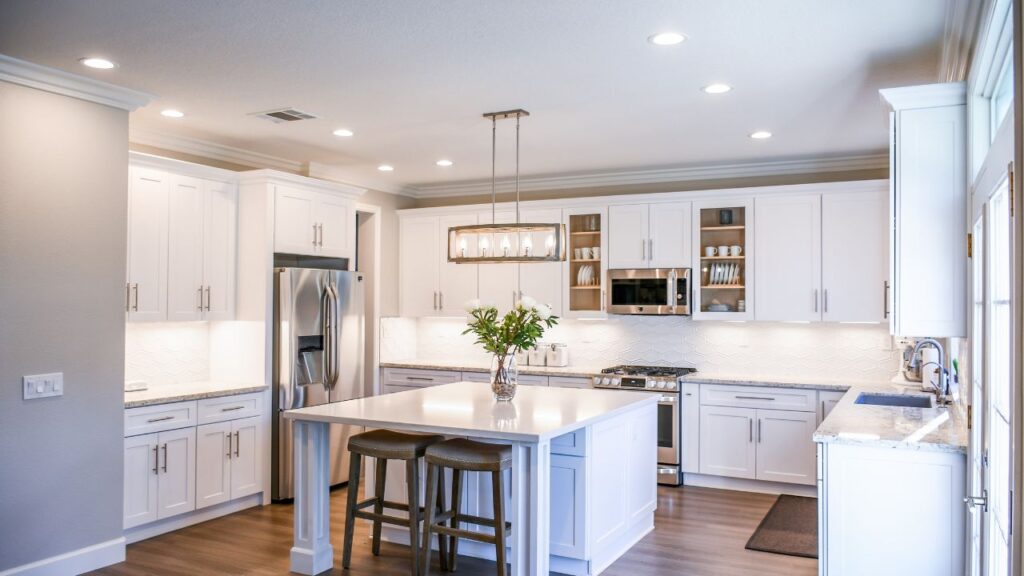Warm Minimalism: Minimalism has long been associated with clean lines, open spaces, and a sense of tranquility. However, the minimalist design of today is evolving, bringing warmth and comfort into the picture. This trend, known as warm minimalism, merges the serene, uncluttered essence of traditional minimalism with cozy, natural elements, making homes feel inviting rather than sterile. Here’s how you can incorporate warm minimalism into your home to create a calm, clutter-free sanctuary.
1. Understanding Warm Minimalism
Before diving into design tips, it’s important to understand what warm minimalism entails. Traditional minimalism focuses on simplicity—paring down furniture, decor, and color palettes to the essentials. Warm minimalism takes this concept a step further by introducing warmth through earthy tones, soft textures, and organic materials. It’s about creating a functional yet inviting space that fosters peace and well-being.
The key difference between minimalism and warm minimalism lies in the emotional quality of the space. While minimalism can sometimes feel cold and impersonal, warm minimalism aims to balance functionality with comfort, making your home both a retreat and a showcase of intentional design.
2. Choose a Warm, Neutral Color Palette
The foundation of warm minimalism is a soothing, neutral color palette. Instead of harsh whites and greys, opt for softer, more inviting tones such as beige, taupe, cream, and warm whites. Earthy hues like terracotta, olive green, and muted browns can also add a natural warmth to your home without overwhelming the minimalist aesthetic.
Tips for Choosing Colors:
- Paint: Choose soft, muted tones for walls to create a calming backdrop. Warm whites or light greys with beige undertones work well to maintain a minimalist feel while adding coziness.
- Accents: Incorporate warmer accent colors like mustard yellow or rust in small doses through pillows, throws, or artwork.
- Natural Wood: Use natural wood finishes for furniture, flooring, and cabinetry to bring a touch of warmth and nature into the space.
A warm, neutral color scheme not only gives your home a cozy feel but also keeps the clutter-free, calm aesthetic of minimalism intact.

3. Incorporate Natural Materials and Textures
To avoid the cold and stark look sometimes associated with minimalism, focus on adding texture through natural materials. In warm minimalism, the emphasis is on creating tactile comfort—soft fabrics, organic materials, and handmade decor bring warmth and personality to a minimalist space.
Materials to Consider:
- Wood: Natural wood, especially in lighter tones like oak or walnut, adds warmth to minimalist spaces. Wood furniture, shelving, and accents can make rooms feel more grounded and organic.
- Stone: Materials like marble, granite, or limestone can add natural elegance without overpowering the simplicity of the design. Consider stone countertops, tabletops, or decorative items like vases and bowls.
- Textiles: Layer soft, inviting fabrics such as linen, wool, or cotton. A chunky knit throw on the sofa or a jute rug can bring tactile warmth to a minimalist room.
- Plants: Houseplants are a great way to add life to your space while adhering to the warm minimalist aesthetic. Choose low-maintenance plants like succulents, snake plants, or peace lilies, which bring a touch of green without cluttering the space.
These natural materials not only add texture but also bring a sense of connection to nature, which is essential to warm minimalism. When done right, these materials create a harmonious balance between simplicity and warmth.
4. Declutter with Purposeful Furniture and Storage Solutions
Decluttering is central to both minimalism and warm minimalism. The difference with warm minimalism is that instead of striving for an empty, stark space, you aim for a well-curated, functional environment.
Tips for Decluttering:
- Quality Over Quantity: Invest in fewer, high-quality pieces of furniture that serve both functional and aesthetic purposes. Look for furniture with clean lines but made of warm materials like wood or upholstered with soft, neutral fabrics.
- Hidden Storage: Choose furniture that doubles as storage to keep clutter at bay. Coffee tables with hidden compartments, under-bed storage, or cabinets with sleek, minimal designs can help maintain a clean and organized look.
- Thoughtful Curation: Keep decor and personal items to a minimum, but make sure they have meaning. A well-placed family heirloom, a cherished piece of art, or a few well-chosen books can add personality without disrupting the minimalist vibe.
In warm minimalism, every piece has a purpose. By focusing on multi-functional furniture and clever storage solutions, you can maintain the minimalist aesthetic without sacrificing the practicality of everyday living.

5. Use Soft Lighting to Enhance Warmth
Lighting plays a crucial role in setting the tone of a minimalist space. Rather than using harsh overhead lights, opt for softer, ambient lighting to create a warm and cozy atmosphere.
Lighting Tips:
- Warm Bulbs: Choose light bulbs that emit a warm, yellow hue rather than cool white light. This instantly makes any room feel cozier and more inviting.
- Layered Lighting: Incorporate a mix of lighting sources such as floor lamps, table lamps, and wall sconces. These can help create soft pools of light that make the space feel intimate and well-lit without overpowering the minimalist aesthetic.
- Natural Light: Maximize natural light wherever possible. Keep window treatments light and airy, and avoid heavy drapes that block out sunlight. Natural light enhances the warm tones of your interior and adds to the calming atmosphere.
With the right lighting, you can transform even the simplest of rooms into a warm, inviting retreat.
6. Embrace Simplicity and Intentionality
Warm minimalism is more than a design style—it’s a mindset. It’s about embracing simplicity, letting go of excess, and making thoughtful decisions about what you bring into your home. Every piece should have a purpose, whether it’s functional or emotional.
Key Principles of Intentional Living:
- Mindful Purchases: Avoid impulse buying. Instead, invest in high-quality items that align with your aesthetic and lifestyle.
- Edit Your Space Regularly: Go through your belongings every few months to assess what you no longer need or love. Letting go of unnecessary items keeps your space clutter-free and maintains the minimalist vibe.
- Personal Touches: While warm minimalism focuses on simplicity, it doesn’t mean your home should be devoid of personality. Select a few meaningful items—such as family photos, travel souvenirs, or handmade crafts—that add character without creating visual clutter.
By following these principles, you can create a home that looks beautiful and feels serene and nurturing.
Conclusion
Incorporating warm minimalism into your home is about finding a balance between simplicity and comfort. You can create a clutter-free, calming space that fosters relaxation and well-being by focusing on a warm colour palette, natural materials, smart storage solutions, and thoughtful design choices. Warm minimalism isn’t about living with less for the sake of it—it’s about living with intention, surrounding yourself with things that matter, and creating a home that feels functional and inviting.

